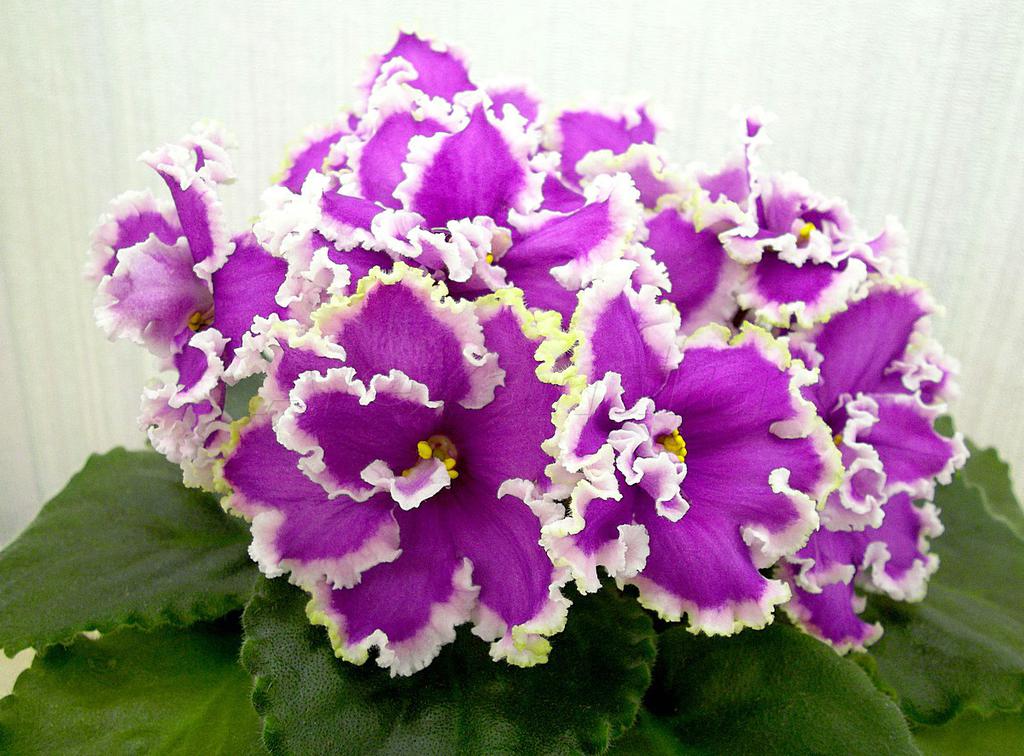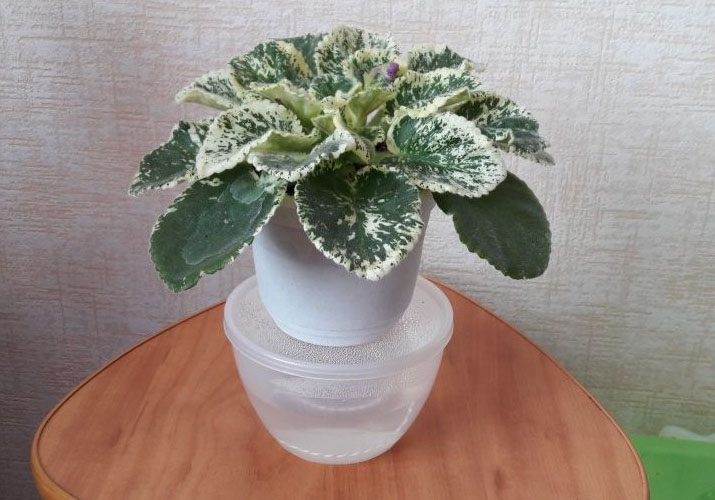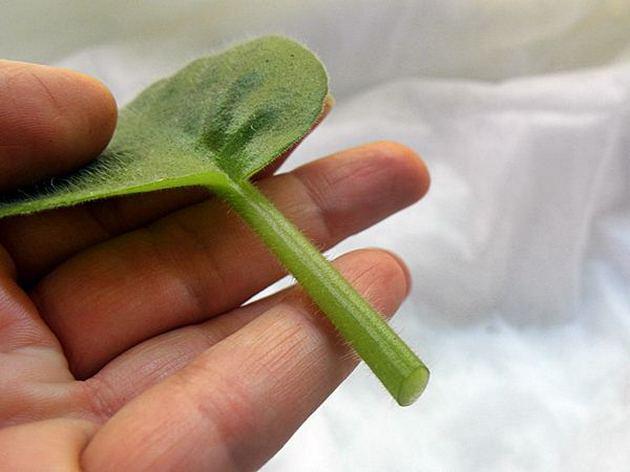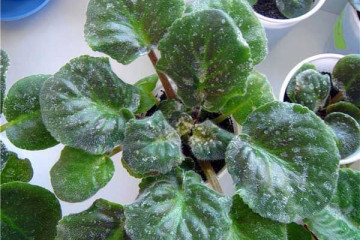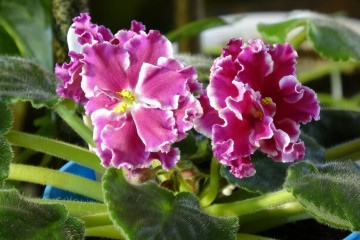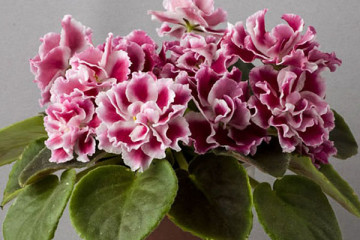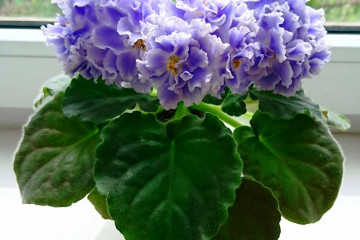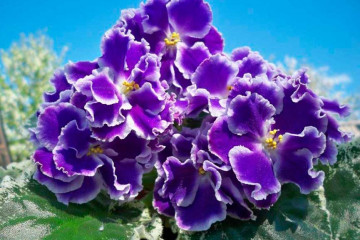Violet Esmeralda - description and characteristics of the variety
Content:
Violet Esmeralda is a gentle, sweet plant that attracts the eyes of everyone around. It fell in love with flower growers for its long flowering and abundance of flowers. However, the flower is not as easy to grow as it might seem at first glance.
What does the violet Esmeralda look like?
Violet LE Esmeralda is a delicate, touching flower that does not stand out for its special brightness and splendor. But at the same time, the flowering is abundant, due to which this whole amazing picture is created.
Plant characteristics
Botanical description of Saintpaulia Esmeralda:
- the flower is large, bright crimson, with fringes along the edges;
- a light green edging runs along the edge of each petal, which brightens over time;
- leaves of a standard oval shape, slightly narrowed towards the end, become wavy over time;
- the color of the edging can be preserved if the room is kept at a stable cool temperature.
Violet Esmeralda belongs to the Gesneriaceae family, the genus Saintpaulia Hybrid.
Briefly about the history of appearance
The violet got its name in honor of the famous gypsy woman from the novel "Notre Dame Cathedral" by V. Hugo. The color of her petals and lace at the edges reminded the breeders working with the variety of this beautiful girl. The variety has several varieties.
The difference between the varieties Esmeralda and Esmeralda Lux
LE Esmeralda Lux is one of the varieties of the hybrid. It was bred by the breeder Elena Lebetskaya, who became the author of most of the varieties. This hybrid is characterized by greater doubleness and petal size. The color saturation is also slightly different. In this case, they are either crimson-burgundy or fuchsia. The light green border along the edge of the flower is unchanged throughout the entire flowering period.
Sport of this type
Any insignificant but regularly recurring difference in a number of plants belonging to this species is considered to be a sport of violets. These differences can be expressed in the form of flowers or leaves. Sport Esmeralda is a completely similar plant, the leaves of which are as curly as the flowers. But the color of the delicate petals itself is completely pink.
Features of caring for a violet LE Esmeralda at home
Like any Saintpaulia, LE Esmeralda is a rather finicky plant, but any florist can cope with its cultivation, especially an experienced one, who has been breeding violets for a long time.
Temperature and lighting
The optimum growing temperature is +18 .. + 24 ° С. The cooler it is in the room, the lighter the petals are.
Proper lighting is one of the keys to success in growing violets. Daylight hours should always last a long time, not only in summer, but also in winter. Therefore, at this time of the year, it is necessary to artificially increase the duration of daylight hours with the help of fluorescent or phyto lamps.In total, violets should be lit for at least 15 hours a day.
Watering, spraying and moisture
Wick or sump watering is preferred. The water should be warm, soft, well-separated.
Violets should not be sprayed, as droplets of moisture form yellow spots on the leaves. The leaves and flowers of the plant, in principle, prefer only bottom watering (through a tray or wick), but you can gently water the flowers at the root.
Violets do not like it when the room is dry. Therefore, the air must be humidified. This can be done using containers filled with water, wet expanded clay, wet moss. For those who have whole collections of Saintpaulias and other moisture-loving plants, it is recommended to purchase an air humidifier.
Priming
The main properties of the soil for violets: nutritiousness and friability. It is best to purchase special soil for Saintpaulias in the store. But you need to carefully look at its composition. If there is no perlite in it initially, then it is worth adding it or coarse river sand.
Top dressing
During the first 6 months after transplanting, additional feeding is not required. Then they are applied depending on the life period.
- At the very beginning of the growing season, nitrogenous fertilizers are applied, which stimulate the active growth of the green part.
- During the flowering period, potash-phosphorus fertilizers are applied, which contribute to a more lush flowering.
Top dressing is done in conjunction with watering. If watering is wick, fertilizers are applied directly to the water.
When and how it blooms
The plant blooms throughout almost the whole year. The flowers are lovely, original. They can be plain or terry, depending on the particular Esmeralda variety, with fringed edges.
The shape of the flowers in this species is Pansies.
The plant blooms almost all year long, with the exception of a short dormant period of 1-2 months.
Special changes in care during flowering are not required. It is important to remove dried buds in time. Top dressing with complex fertilizers is carried out 2 times a month.
How Saintpaulia LE Esmeralda reproduces
Reproduction of large-flowered Saintpaulia LE Esmeralda occurs only by cuttings or peduncles. The most popular method is grafting.
For this, the strongest sheet from the second row is selected. It is placed in a glass of warm boiled water. As soon as the root system grows to about 1 cm, the shoot can be planted in the prepared soil.
It is possible to plant the leaf in the substrate immediately. It needs to be buried about 1/3 of its entire length and covered with plastic or a glass jar.
Transplant after purchase and during reproduction
After purchase, the violet should not be transplanted immediately. She must go through the incubation period in the same container in which she grew up in the store. For 14 days, the plant should be protected from the rest, it is advisable to place it in a separate room. This is necessary in order to protect home flowers from diseases and parasites that Saintpaulia can bring with it.
Further transplantation is carried out by transshipment. A transplant to a new place is carried out 1 time in 2 years, it is possible more often, but not less often. At the same time, the size of the pot should increase slightly each time, but it should not be too deep.
In a large pot, the growth of the plant will slow down as it will be absorbed primarily by the build-up of the root system.Only after it wraps around an earthen ball, the ground part will begin to develop.
Possible growing problems
Most of the problems are due to improper care, but there are also diseases that Saintpaulias are prone to. Occasionally, the violet is attacked by pests.
Leaf problems
Leaf problems are most often associated with improper care. So, yellowing, the appearance of spots on the leaves is most often associated with hypothermia. Watering with cold water or excess moisture can provoke the development of root or stem rot, as a result of which the leaves will droop and turn black.
Lack of light will provoke stretching, lengthening of the cuttings. And excess lighting and heat can cause wilting, drying out and sunburn on the leafy part.
Pests
The main parasitic insects that can harm the Saintpaulia LE Esmeralda:
- Ticks that cannot be seen with the naked eye. They settle on aging leaves. Traces of their vital activity appear in the form of white dots on the leaves. The leaves affected by ticks are cut off.
- Thrips. They can also only be seen under a microscope, but unlike ticks, they can fly. Indoor plants most often fall from the street together with pollen or poplar fluff.
- Aphids can kill a violet. The external manifestation of its vital activity is the wilting of the leaves, which then turn yellow and fall off.
To combat any insect pests, special preparations are used - insecticides, which can be bought at any flower shop.
Diseases
The most common diseases are:
- Powdery mildew (true or false), characterized by the appearance of a powdery white coating on the leaves and stems. The false variety is also accompanied by brown spots on the leaf blades.
- Rust affects the leaves, which are covered with rusty spots, then the rest of the flower suffers.
- Root and stem rot are the most dangerous diseases that occur in Saintpaulias as a result of hypothermia and / or overflow. The appearance of this disease is detrimental to plants. If a flower is found, you can throw it away, since it will not be possible to save it, and the pot is well disinfected.
Signs of improper care
- with a lack of light, the new leaves will be lighter and smaller, the petioles will stretch out, the edges of the leaves will bend up;
- increased acidity or excessive salinity of the soil leads to twisting of the leaf plates, the same problem occurs with a lack of nitrogen or overflow;
- light spots on the leaves or their tips hint to the grower that the flower is watered with too cold water or suffers from sunburn.
It is better for beginners not to take up the cultivation of this plant, it is worth practicing on more unpretentious flowers.
Saintpaulia Esmeralda fully justifies its name with its bright double flowers, of which there are many, starting from the first flowering. This variety will definitely be an adornment for any collection. However, for beginners it is better not to take up growing this variety, since it is not so easy to cope with this.
